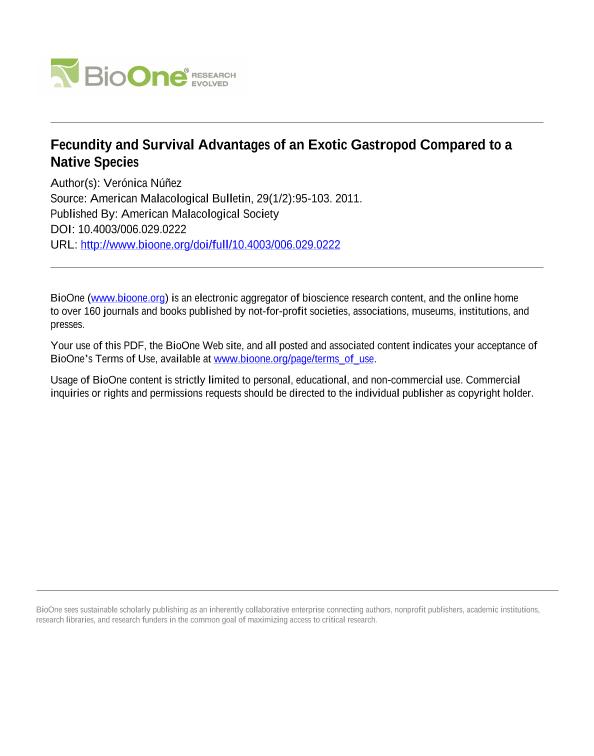Artículo
Fecundity and Survival Advantages of an Exotic Gastropod Compared to a Native Species
Fecha de publicación:
03/2011
Editorial:
American Malacological Society
Revista:
American Malacological Bulletin
ISSN:
0740-2783
Idioma:
Inglés
Tipo de recurso:
Artículo publicado
Clasificación temática:
Resumen
In Argentina the exotic snail Physa acuta Draparnaud, 1805 is predominant in environments previously inhabited by the native species Stenophysa marmorata Guilding, 1828, raising the question of whether this could have occurred because of differences in survival or reproductive strategies. To analyze the life cycle of these two species, I used the horizontal—life-table method and considered the number and proportion of viable of eggs per oviposition. Although both species suffered a high degree of mortality during the first weeks after oviposition, both the rate and the force of mortality was much greater during the reproductive period, so that the survival curve was not as markedly concave as with other gastropods. Physa acuta survived longer than S. marmorata, began its reproductive period earlier, and had a longer and more continuous reproductive stage. The number of ovipositions per snail was not different between the two species; but since the mean number of eggs per oviposition was higher in P. acuta, fecundity was likewise higher. The increase in fecundity was accompanied by an enhancement of the mortality rate in S. marmorata. The percentage of viable eggs was higher in P. acuta than in S. marmorata, but fecundity increased with age in both species. Life expectancy, reproductive value, and net reproductive rate were higher in P. acuta. The success of the exotic species P. acuta in the native habitat of S. marmorata could be explained in part by the former's earlier sexual maturation, higher reproductive potential, and greater longevity. Further field and laboratory studies are needed to demonstrate the existence of interspecific competition between these two gastropods.
Palabras clave:
LIFE CYCLE
,
PHYSIDAE
,
REPRODUCTION
,
SURVIVORSHIP
,
INTRODUCED SPECIES
Archivos asociados
Licencia
Identificadores
Colecciones
Articulos(CCT - LA PLATA)
Articulos de CTRO.CIENTIFICO TECNOL.CONICET - LA PLATA
Articulos de CTRO.CIENTIFICO TECNOL.CONICET - LA PLATA
Citación
Nuñez, Maria Veronica; Fecundity and Survival Advantages of an Exotic Gastropod Compared to a Native Species; American Malacological Society; American Malacological Bulletin; 29; 1-2; 3-2011; 95-103
Compartir
Altmétricas




